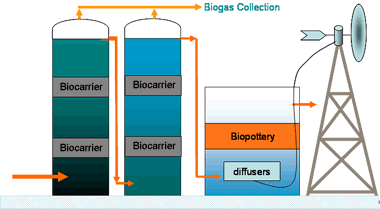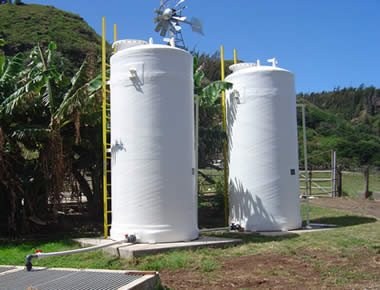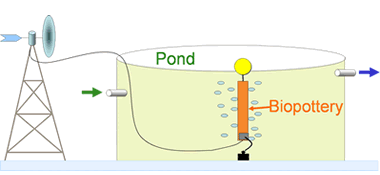Solution
What is a biocarrier reactor?
The milking wastewater contains lipids and fats that cause traditional anaerobic reactor failure or bad performance, because lipids cause anaerobic bacteria to float and wash out. To solve these problems, University of Hawaii scientists and engineers developed a new anaerobic reactor (patent pending), the biocarrier reactor. Similar to a birds' nest holding birds' eggs, biocarrier is special plastic nest “holding” bacteria.
 |
Figure 1: UH patent-pending technology, the anaerobic biocarrier reactors (left two) treat dairy wastewater four times faster than conventional methods. It can be operated at 18–40°C ambient temperature with 75% pollutant removal at a pollutant loading rate of 15 kg/m3/day, and it recovers biogas with 70% methane. The right open top reactor is the aerobic biopottery reactor.
|
How does it work?
Each of the two large tanks contains two layers of biocarrier, providing a large surface area for bacteria to attach and grow. The biocarrier not only holds bacteria but also provides a better mixing between the bacteria and pollutants. When the biocarrier reactors are fully operated, they are full of bacteria from bottom to top. The high concentration of bacteria, which “eat” and convert pollutants to biogas, make the biocarrier reactor a much better performance than conventional bioreactors. In this project, the biocarrier reactors showed great advantages:
- They remove more than 80% of pollutants.
- The wastewater treatment takes less than 18 hours (conventional reactors take three days).
- This short hydraulic retention time means you can use a smaller reactor than with conventional systems to treat the same volume of wastewater.
- They only need two weeks to start up, while conventional reactors need two or three months.
- The biogas produced by biocarrier reactors contains about 70% methane gas, which can be used as fuel.
Applications
The biocarrier reactors were specially designed for dairy wastewater treatment, but their applications are not limited to dairy wastewater only. They also can be used to treat other concentrated organic wastewaters, such as slaughterhouse wastewater and food industrial wastewater. Since the biocarrier reactors are capable of holding high bacteria concentrations and producing high-quality biogas, they may also be used as bio-energy recovery digesters or renewable energy producers.
 |
The anaerobic biocarrier reactor at Waialee Livestock Research Station is the fastest anaerobic reactor for dairy wastewater treatment in the world. It can be operated at 18–40°C ambient temperature with 75% of pollutant removal at a pollutant loading rate of 15 kg/m 3 /day and recovers biogas with 70% methane. |
What is biopottery?
Biopottery is a highly porous and shrinkable pottery that automatically selects and immobilizes microorganism for polluted water treatment.
Sludge and clay are used as ceramic raw materials to make high-porosity pottery. During the ceramic firing process, the organic content of sludge makes pores when it is burned, while the inorganic content remains. It also provides a large surface area and inorganic nutrients that can support growth of activated bacteria. When submerged in wastewater, this pottery attracts and immobilizes bacteria. These highly activated bacteria, once inside the pottery, will “eat” pollutants when wastewater is passed through it, thus making the water cleaner. The pottery with resident activated bacteria is called “biopottery.”
 |
Figure 2: The biopottery-windmill pond cleanup system integrating biotech and windmill aeration technology cleans water from animal production systems for reuse. This easy-to-install system is a cost-effective, energy-efficient approach to treat polluted lakes and rivers in situ.
|
How does it work?
The biopottery technology uses the advantages of microorganism cell immobilization. Immobilization of microorganism cells in a water-permeable, porous media has been recognized as a highly efficient wastewater treatment approach compared to the more conventional suspended activated sludge and attached growth methods (Yang and Wang, 1988). This method can remove carbon- and nitrogen-based pollutants in a single process (Yang et al., 1997).
Most microorganism immobilization methods use cultured bacteria separation and coating processes, which mean coating permeable organic material with cultured activated sludge. Instead of using organic material and coating pre-selected bacteria, biopottery technology applies inorganic material and auto-selective and immobilization processes when pottery is used in water and wastewater treatment process.
The advantages are that the process is simplified, cost-effective, and easy to operate.
Applications
Biopottery reactor
A 2000-gallon open-top plastic tank was filled with 20 cm biopottery in a stainless-steel screen holder. An aeration system was installed under the holder. The pretreated wastewater from the biocarrier reactor flows to the bottom of the biopottery reactor. The biopottery reactor is able to remove 35–50% of the total chemical oxygen demand and 80% of the ammonia; meanwhile, odor gas such as hydrogen sulfide and ammonia is oxygenized in the biopottery reactor, which leads to reduced odor problems and makes the air cleaner. The aeration is provided by two windmill air pumps.
Biopottery-windmill clean-up systems
The oxidation pond receives pretreated wastewater from a septic tank and some runoff from farm buildings. The overflow from the pond is released to a discharge well. In order to improve the treatment of pond and eliminate the odor from the pond, three biopottery-windmill cleanup systems are installed.
The system is the integration of the biopottery and windmill aeration systems. Each system includes 50 pounds biopottery held by a stainless-steel cage with air diffusers and a windmill. The cage of biopottery connected to a floating ball and suspended in the water works as a bioreactor. The air bubbles generated at the bottom of the cage not only provide oxygen needed by the bacteria inside the biopottery, it but also draws the water around the cage to pass through the biopottery. Furthermore, the floating ball drags the cage and maximizes the contact area between biopottery and water. These three systems installed significantly help to improve effluent quality. The analysis data show that they reduce COD by 35% and ammonia by 75% compared to the levels before system installation.
 |
The biopottery-windmill pond cleanup system at Waialee Livestock Research Station integrates biotech and windmill aeration technology to clean water from animal production systems for reuse. This easy-to-install system is a cost-effective, energy-efficient approach to treat polluted lakes and rivers in situ.
|
Potential Applications
Polluted river in-situ bioremediation
Biopottery also can be used for polluted river remediation because of the cost-effective material and highly concentrated activated sludge immobilization capacity.
Drinking water pretreatment
Since biopottery has a high porosity and high permeation capacity (6–9m/hour), it can be used as an ideal filtration medium to replace slow-sand filtration and increase treatment efficiency. Slow-sand filtrations are widely used in the USA in drinking water pretreatment for the removal of bacteria, pathogens, and viruses.
|